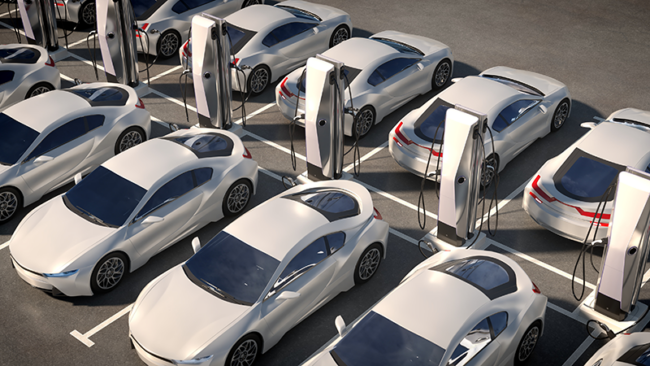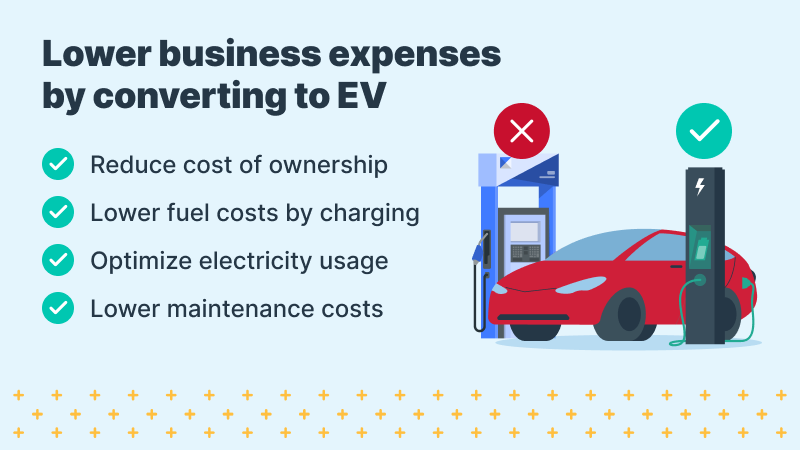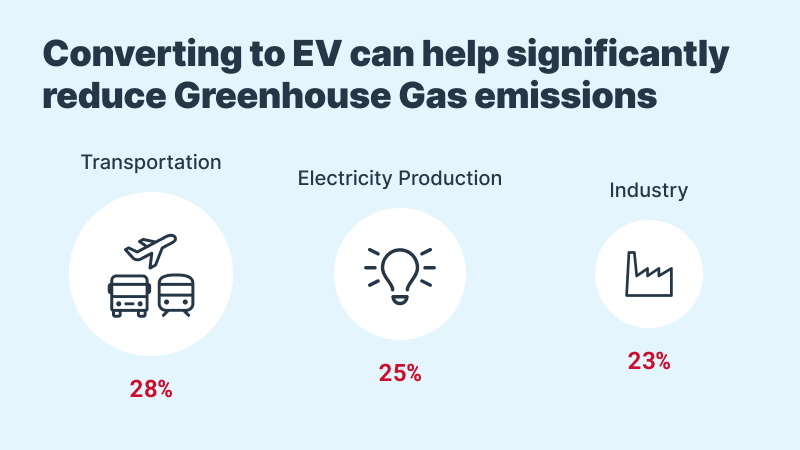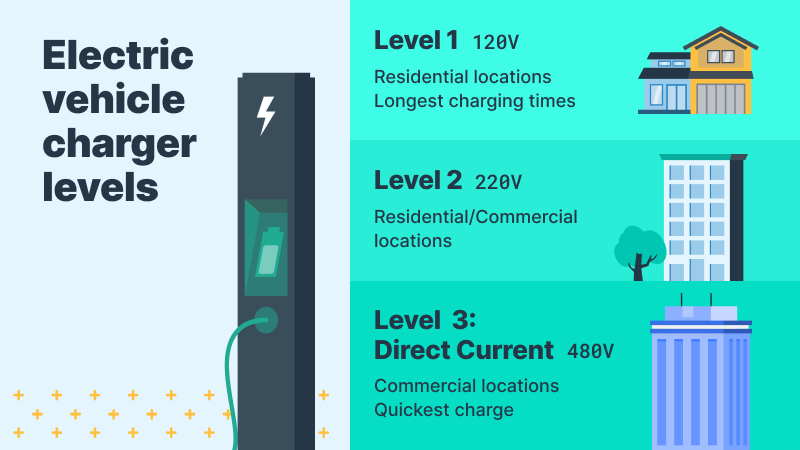Stay connected
Subscribe to our fleet blog and follow us on social media to receive all our fuel and energy industry insights.

For the world to continue moving at the current pace, sustainable change needs to be a way of our lives. One way fleet businesses can be more environmentally conscientious is by transitioning some or all of their fleets to electric vehicles.
Before a business adopts electric vehicles into their fleet, there is a significant learning curve that comes with owning a battery-powered vehicle. To optimize your investment in electric fleets, it is important to understand what it takes to operate them and the myriad unexpected details tied to adding EVs to your fleet.

Traditional fleet management is changing due to an increase in electric vehicle adoption. The Street’s Ian Krietzberg reported on a continued rise of EV sales in the U.S., with 2023’s numbers on track for EVs to represent 9% of all new car purchases – this is up from 5.8% in 2022 and 3.2% in 2021. And then Cox Automotive reports that EV sales reached 1.3 million in 2024 in the U.S., which is an increase of 7.3% from 2023’s total. Goldman Sachs Research also forecasts EV’s to make up half of all global car sales by 2035.
For businesses and public sector organizations, integrating EVs into your fleet is now inevitable. There are significant environmental, financial, and operational benefits that come from embracing this technology. Although the adoption of electric vehicles for fleets is becoming increasingly more popular, there are still some major misconceptions in the marketplace. For a successful EV integration, there are certain steps to follow to optimize your experience and the experience of your drivers.
Since EV adoption sharply rose in recent years, fleet managers, who have chosen to adopt EVs without partnering with an EV adoption expert, have been experiencing operational and technological issues that might have been avoided. No two businesses have the exact same needs when it comes to their fleet, which means there’s not a single clear-cut answer to solve everyone’s EV transition needs. It’s important for customers to find a trusted fleet management partner to help them adopt electric vehicles.
Although there are many complexities to converting traditional internal combustion engine (ICE) fleets to mixed-energy fleets, there are significant benefits that EVs can bring to your business. First and foremost, electric vehicles can lower operational costs in several ways. These include:

EV maintenance costs are lower than what you’d find with traditional gas counterparts. This is because EVs have fewer mechanical parts so there is less to oversee. Mechanical parts are prone to failure and use data for preventative maintenance measures, so having less of them in your vehicle means lower costs. With a well-executed charging infrastructure and a trusted fleet management partner, implementing EVs can improve operational efficiency. There is also a dramatic difference in costs when fueling an ICE vehicle as compared to fueling an EV. When EVs are adopted there is significant long-term savings to be had on fueling alone. According to the US Office Of Energy Efficiency and Renewable Energy, full battery electric vehicles cost of ownership is $0.061 per mile while ICE vehicles cost $0.101 per mile. This may not seem significant, but over time this can amount to significant savings: Fleet drivers can clock in anywhere from 80,000 to 110,000 miles annually, so those costs per mile can add up quickly. The report also states that maintenance costs for medium-duty and heavy-duty EV trucks come in at 40% less than that of ICE vehicles. The reduced cost in addition to optimized electricity usage can further increase your bottom line and maximize operational efficiency.
The most substantial benefit to operating a mixed-energy fleet is the reduced carbon footprint your business transportation sector is leaving on the environment. The top source of greenhouse gas emissions, which emits 1.9 billion tons of CO2 annually, is cars, trucks, planes, trains, and boats. To sustain company growth and future success, limiting the CO2 your company emits into the atmosphere from cars and trucks might be a great place for your business to start its sustainability journey. If your business operates a fleet of vehicles, look into electrification and make a decision that is best both for your needs and for the needs of our planet.

Here are seven key opportunities to be aware of as you develop your EV adoption plan:
Even with all the benefits that come after implementing a mixed-energy fleet, the transition period is the most important part to get right. To maximize the benefits EVs have to offer, the correct infrastructure needs to be in place to accommodate the charging required for the vehicle to operate.
Transitioning smoothly from a fleet composed of ICE vehicles to a mixed-energy fleet makes a difference in a business’s overall operation. Although EVs offer a wide range of benefits in the long term, a smooth transition from all ICE vehicles to a mixed-energy fleet can set your business up for long-term competitive advantage. A phased approach is recommended before committing to all-electric. Understanding all the pieces of this process up front, as the customer, is crucial. As mentioned before, having a trusted EV fleet management partner to walk you through this process is important to ensure success. A fleet partner will set the right expectations of the required steps outlined above to help you most efficiently transition to operating an electric fleet.
An electric fleet needs to have a frictionless and efficient charging system that meets the needs of a business. Charging stations and locations need to be predetermined for any business operating battery-powered vehicles. Mapping out how your EVs will be charged during a workday is more complicated than planning for visits to traditional fueling stations. Charging stations work most efficiently when they are used while the car sits idle, like parked overnight or while not in use for hours at a time.
Shifting to a mixed-energy fleet might make sense for one business or government organization, but not for another. It’s important to note that not all situations are the same and fleets are used for a variety of purposes. The daily range a driver travels is a big factor to consider when first looking at EVs. Depending on the distance a driver covers daily, a hybrid or ICE vehicle may be a better fit than an all-electric vehicle. If a fleet is staying within 200-300 miles per day, an EV would be a great fit for those needs. Each use case is different, which is why businesses benefit from having an expert help them find the best fit for each vehicle in their fleet.
Although from a decarbonization perspective there is significant value gained from sustainability, this is only applicable if mixed-energy fleets are implemented correctly. EVs need to be adopted and folded into your operations thoughtfully and planfully. For a seamless transition, businesses should have transparent conversation with their fleet solutions provider about what would best fit their needs.
Depending on a business’ needs and size, your vehicles might either be parked at employee homes or be returned to a parking lot overnight. Businesses need to determine where the vehicle sits idle for the most amount of time to optimize operations and make the best use of the battery range of the EVs in their fleet. Charging at home or in a depot requires substantial infrastructure that needs thorough planning ideally before electric vehicles are purchased and become part of your operations.
When managing a mixed-energy fleet, the payback system for fueling is not as simple as a fuel card that you can simply swipe. Identifying where a vehicle sits idle will help you determine the best way to charge your fleet and maximize operations.
If a business determines their fleet drivers will charge vehicles at home, a dedicated home charger will be required. The first step is to learn if the driver owns their home to determine if they can install a home charger. If they rent, they will likely have to find another solution besides at-home charging and potentially look into depot charging. If the driver does own their home, the home itself needs to be evaluated for its ability to support a charger and the electricity it requires. These are some of the questions that need to be answered before purchasing an electric vehicle for your fleet.
The location where the vehicle sits idle is an important data point for the business to understand, but the biggest factor to evaluate is which charging setup makes the most sense for your fleet. A standard level 1 charger typically has a three pin plug and requires a minimum of a 120-volt compatible plug – a common wall outlet. The level 1 charger is great for those who travel around 40 miles daily and want to replenish overnight. It’s possible your drivers will need more range than this, in which case a level 2 or level 3 direct current (DC) fast charging setup is recommended. Which level you choose also depends on the car and the speed of charging you’ll want.
If your business is interested in a faster charger for more battery power and a longer range, then a level 2 charger is recommended. This requires a 220 volt outlet. For a 220 volt outlet you’ll need a professional to install it for you, and this level of charger may require further electrical work to ensure that the home is up to code. This would be an additional cost for your business.
While level 3 chargers are the fastest, they are also the most expensive. CNBC’s Cheryl Munk reported that investing in multiple level 3 units can cost anywhere from $500,000 to $1 million. But as the EV market is growing, so is the support for more supercharger installations. Fueling stations like BP and Shell are already receiving support from big oil companies to mitigate the declining number of stations across the U.S. Increasing sales of hybrid vehicles also incentivizes the push for more EV chargers in gas stations. So as charging locations become more widespread, determining the correct EV charging set-up could become easier.

A business that needs a DC fast charging station should look into building a charging depot. If your business identifies a charging depot would best suit the needs of your operations, planning and preparation are key to your success. Building a charging ecosystem takes time and planning expertise as well as an investment in land and equipment. This can be a long process that your business needs to understand and map out before starting.
The reimbursement process for charging at home and when using a charging station en route can be confusing. That is why fleet partners have developed solutions to simplify this process. Companies like WEX partner with EV contractors like ChargePoint to enable easy payments at public fast chargers. An RFID card or a phone application is typically used at charging stations throughout the U.S. to pay for fueling as opposed to the magstripe fuel cards used to pay for traditional fuel. For drivers charging at home, fleet managers will need access to the data showing the amount of energy used for every charge made. This will allow businesses to reimburse employees for the electricity used for charging. How this works can be dependent on the installation process and how each business decides to reimburse their drivers. It is hard to monitor electricity usage and how much fleet vehicles charge. Even with all these complexities, a mixed-energy fleet is most manageable with the right guidance and recommendations.
In order to successfully transition to an EV fleet, you need a knowledgeable consultant and expert to recommend the right vehicle and walk you through the entire setup process. Understanding not only the deployment and charging process, but which EV to select are important considerations. A trusted fleet solution provider will help you understand which vehicle is right for you, as well as which charging setup is necessary. All of that initial set-up is directly tied to how charging reimbursements or payments are handled. This can be an incredibly difficult part of the process, since electricity bills are more complex than a simple swipe of a fuel card. This means nailing how you’re going to go mixed-energy at the beginning of the process can make a huge difference in the success of your EV adoption.
Although EVs have been in use since the 90’s, they are just now being used more frequently in fleet management. This means the technology and solutions fleet partners offer for these vehicles is still in development. A trusted fleet partner is the most reliable source your business can use for guidance and recommendation when considering a transition.
It is vital that fleet electrification is done correctly. Making sustainable and green choices in our everyday lives now affects our carbon footprint and sets us up for a more livable future. You’ll get the most value from your investment into building a mixed-energy fleet if you partner with a knowledgeable expert like WEX.
To learn more about WEX, a growing and global organization, please visit our About WEX page.
To learn more about WEX’s EV offerings visit our EV page.
Editorial note: This article was originally published on January 18, 2023, and has been updated for this publication.
Resources:
ANS Corporate
McKinsey
Consumer Reports
ElectricForAll.org
Motor Trend
Amp Up
The Street
Goldman Sachs Research
CNBC
U.S. Office of Renewable Energy
Environmental Protection Agency
Cox Automotive
Subscribe to our fleet blog and follow us on social media to receive all our fuel and energy industry insights.